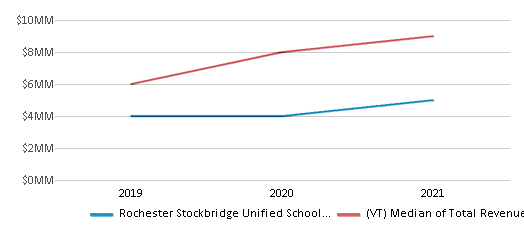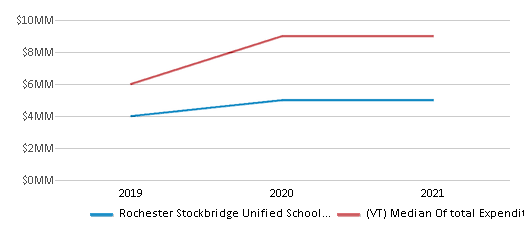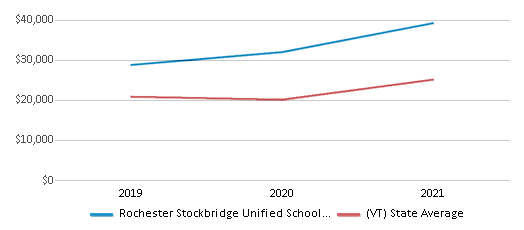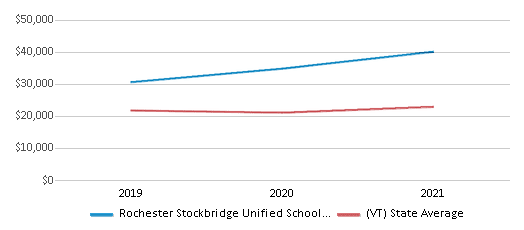For the 2025 school year, there are 2 public preschools serving 128 students in Rochester Stockbridge Unified School District #81. This district's average pre testing ranking is 4/10, which is in the bottom 50% of public pre schools in Vermont.
Public Preschools in Rochester Stockbridge Unified School District #81 have an average math proficiency score of 33% (versus the Vermont public pre school average of 35%), and reading proficiency score of 33% (versus the 44% statewide average).
Minority enrollment is 5% of the student body (majority Hispanic), which is less than the Vermont public preschool average of 12% (majority Hispanic and Black).
Overview
This School District
This State (VT)
# Schools
2 Schools
206 Schools
# Students
128 Students
46,059 Students
# Teachers
12 Teachers
3,913 Teachers
Student : Teacher Ratio
11:1
11:1
District Rank
Rochester Stockbridge Unified School District #81, which is ranked within the bottom 50% of all 102 school districts in Vermont (based off of combined math and reading proficiency testing data) for the 2021-2022 school year.
Overall District Rank
#92 out of 154 school districts
(Bottom 50%)
(Bottom 50%)
Math Test Scores (% Proficient)
33%
33%
Reading/Language Arts Test Scores (% Proficient)
33%
44%
Students by Ethnicity:
Diversity Score
0.09
0.22
# American Indian Students
n/a
123 Students
% American Indian Students
n/a
n/a
# Asian Students
n/a
793 Students
% Asian Students
n/a
2%
# Hispanic Students
4 Students
1,585 Students
% Hispanic Students
3%
4%
# Black Students
1 Student
1,105 Students
% Black Students
1%
2%
# White Students
122 Students
40,594 Students
% White Students
95%
88%
# Hawaiian Students
n/a
25 Students
% Hawaiian Students
n/a
n/a
# Two or more races Students
1 Student
1,834 Students
% of Two or more races Students
1%
4%
Students by Grade:
# Students in PK Grade:
24
8,002
# Students in K Grade:
14
5,134
# Students in 1st Grade:
13
5,329
# Students in 2nd Grade:
19
5,694
# Students in 3rd Grade:
11
4,859
# Students in 4th Grade:
13
5,179
# Students in 5th Grade:
17
4,374
# Students in 6th Grade:
17
3,343
# Students in 7th Grade:
-
1,679
# Students in 8th Grade:
-
1,675
# Students in 9th Grade:
-
201
# Students in 10th Grade:
-
214
# Students in 11th Grade:
-
206
# Students in 12th Grade:
-
170
# Ungraded Students:
-
-
District Revenue and Spending
The revenue/student of $35,594 is higher than the state median of $29,860. The school district revenue/student has declined by 9% over four school years.
The school district's spending/student of $36,352 is higher than the state median of $29,121. The school district spending/student has declined by 9% over four school years.
Total Revenue
$5 MM
$2,348 MM

Spending
$5 MM
$2,290 MM

Revenue / Student
$35,594
$29,860

Spending / Student
$36,352
$29,121

Best Rochester Stockbridge Unified School District #81 Public Preschools (2025)
School
(Math and Reading Proficiency)
(Math and Reading Proficiency)
Location
Grades
Students
Rank: #11.
Rochester School
(Math: 30-39% | Reading: 30-39%)
Rank:
Rank:
4/
Bottom 50%10
222 South Main Street
Rochester, VT 05767
(802) 767-3161
Rochester, VT 05767
(802) 767-3161
Grades: PK-6
| 89 students
Rank: #22.
Stockbridge Central School
(Math: 21-39% | Reading: 21-39%)
Rank:
Rank:
3/
Bottom 50%10
2933 Vt Route 107
Stockbridge, VT 05772
(802) 234-9248
Stockbridge, VT 05772
(802) 234-9248
Grades: PK-6
| 39 students
Recent Articles

Year-Round Or Traditional Schedule?
Which is more appropriate for your child? A year-round attendance schedule or traditional schedule? We look at the pros and cons.

Why You Should Encourage Your Child to Join a Sports Team
Participating in team sports has a great many benefits for children, there is no doubt. In this article you will learn what those benefits are.

White Students are Now the Minority in U.S. Public Schools
Increasing birth rates among immigrant families from Asia and Central and South America, combined with lower birth rates among white families, means that for the first time in history, public school students in the United States are majority-minority. This shift in demographics poses difficulties for schools as they work to accommodate children of varying language abilities and socio-economic backgrounds.





